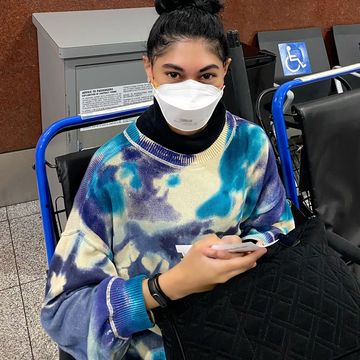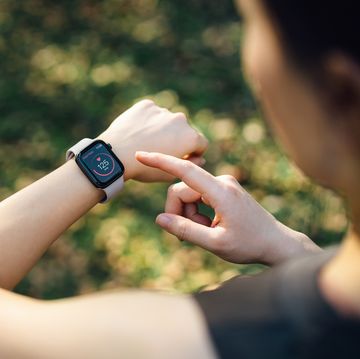It’s unsettling when any part of your body hurts, and feeling pain under left breast could be especially worrying. After all, lots of important organs and structures sit on that side of the body, like your heart, left lung, stomach, spleen, esophagus, ribs, and more.
But if you're experiencing pain there, don't jump to any conclusions because it isn’t always caused by issues with these organs.
“It really depends on the context,” says Samantha Nazareth, MD, a gastroenterologist and WH advisor. “How old is the person, what was the person doing, what is the type or quality of the pain, what is their medical history, what medications are they on, are they having other symptoms?” You have to take all these details into consideration.
More From Women's Health

Pain can also originate from issues with hormones, or you could straight-up just be sore from the gym, says Jayne Morgan, MD, a cardiologist and the clinical director of the Covid Task Force at the Piedmont Healthcare Corporation.
That said, sometimes the pain is related to an underlying medical issue. So, it might be a good idea to get checked out by your doctor and make sure they ask you the proper questions and give you a physical exam, Dr. Nazareth says.
Meet the experts: Samantha Nazareth, MD, is a board-certified gastroenterologist. Jayne Morgan, MD, is a cardiologist and the Covid Task Force Clinical Director at the Piedmont Hospital in Atlanta.
That’s why it’s important to keep tabs on your body and what type of pain you’re feeling. They will clue you in to what may be causing your pain and how to treat it. Here are 10 possible reasons you might be experiencing pain under your left breast, according to medical experts.
1. Muscle Soreness
If you notice discomfort under your left breast after an intense workout involving the chest muscles or other muscles in the area that you don’t normally use, there’s a good chance you’re just sore. Your muscles might be tender to the touch, and the pain might feel dull, tight, and achy, Dr. Nazareth says. It’s also possible that it hurts more when you take a deep breath or press on the chest.
If the soreness is mild, it’ll go away within a few days to weeks, and it probably won’t spread to other parts of the body.
Dr. Nazareth recommends resting and applying hot or cold therapy. Put crushed ice in a bag or use a hot compress or heating pad and leave it on the affected area for up to 20 minutes for two days after the injury. Repeat every two hours if you need extra relief. You'll want to apply heat 48 hours after the injury so it doesn’t increase inflammation, though.
If that doesn't do the trick, try an over-the-counter pain reliever or cream or gel that has pain-relieving and anti-inflammatory effects. Dr. Nazareth's rec is a capsaicin or salicylate creams or gels, which can be used three to four times a day.
2. Acid Reflux
Acid reflux happens when acid flows from the stomach back into the esophagus, or food pipe, Dr. Nazareth explains. It feels like a squeezing or burning sensation in your left and center chest that can spread to your neck, back, jaw, or arms.
Sometimes, you’ll also feel a sour or bitter taste in your mouth, nauseous, and even develop a cough. It typically occurs after meals and sometimes with stress, and it’s normally felt when you lie flat—it can last anywhere from a few minutes to a couple of hours, Dr. Nazareth notes.
An antacid or other over-the-counter acid can sometimes help you get rid of the issue. But adjusting your diet, like stop eating three hours before bedtime and avoid foods that can make it worse, like coffee or caffeinated foods, spicy foods, chocolate, alcohol, peppermint, and fatty foods can also help. (Quitting smoking also helps with reflux, Morgan continues.) If your symptoms continue, it’s a good idea to see your doc.
3. Costochondritis
Costochondritis occurs when you have inflammation in the cartilage that joins your ribs to the breastbone (this area is known as the costochondral joint). The pain, which usually affects the lower ribcage, might feel dull and gnawing, and it’ll feel more intense if you touch the area, take a deep breath, or cough. It may start on the left side of your chest and spread out to the rest of your chest, according to Cleveland Clinic.
It’s not totally clear why some people develop this condition, though. “In some people it might be caused by trauma, heavy lifting, hard exercise, or an illness,” Dr. Nazareth explains.
The pain typically goes away on its own, but you should avoid lifting or pushing heavy things for a few weeks. In the meantime, you can do some stretches to relieve the pain, like the doorway stretch and sphinx pose, and you can also use a heating pad on the area.
4. Tietze Syndrome
This is often confused with costochondritis because it's also marked by inflammation in the costochondral joint. They share almost identical symptoms, but the the pain caused by Tietze syndrome is usually felt closer to the shoulder and affects the upper ribcage, per Cleveland Clinic. You'll also notice chest swelling, which is absent in costochondritis.
Depending on which ribs are affected, it might hurt more when you move or twist your upper body. You may also feel the pain more when you sit or lie down in certain positions. Coughing, sneezing, and vomiting may also be painful.
No one really knows what causes it—some believe it's due to small traumas to the chest from straining during exercises, a respiratory infection, or coughing fits, Dr. Morgan notes.
You’ll want to get it checked out by a doc and let them know if you feel increased tenderness when they press on your chest in the affected area. Tietze syndrome can be treated with rest and OTC anti-inflammatory medications, usually resolving in one to two weeks, says Dr. Morgan.
5. Pleurisy
If you feel sharp, stabbing chest or shoulder pain when breathing in deeply, there’s a chance it could be a result of pleurisy, which is inflammation of the lining of your lungs (a.k.a. pleura). It occurs when inflammation in your lungs moves into the pleurae and causes them to swell up and rub against each other, per Cleveland Clinic.
The pain can accompany a viral infection or result from a chest injury or pneumonia, in which case you would also have a fever and cough, says Dr. Nazareth.
If you have pneumonia and it's untreated, it’s possible that bacteria from an infection can enter the bloodstream and affect your other organs, so see a doctor ASAP. If the pleurisy is caused by a virus, it might take a couple of days for the pain to go away, but if it’s bacterial pneumonia, the pain will most likely stay until it’s treated, Dr. Nazareth says.
6. Hiatal Hernia
A rarer cause of pain under your left breast, a hiatal hernia is when your upper stomach bulges through the diaphragm, which separates your abdomen and chest, according to Mayo Clinic. The painful sensation might feel like a pulling or tearing from the diaphragm right below the left breast, Dr. Morgan explains.
You might feel this pain when you have increased intra-abdominal pressure, like when lifting weights, groceries, or other heavy objects. It usually lasts as long as you’re doing the movement that is causing the pain.
Small hiatal hernias won't cause any other symptoms, but larger ones could come with heartburn, acid reflux, shortness of breath, feeling full soon after you eat, vomiting blood, and black stools.
Talk to your doc if you think you have a hiatal hernia because it generally requires a surgical repair, Dr. Morgan says.
7. Pericarditis
Pericarditis is inflammation of the outer lining of the heart, also called the pericardium, Dr. Morgan explains. Chest pain occurs when the swollen and irritated layers of the pericardium rub against each other.
A viral infection like COVID, autoimmune diseases like lupus, and injury to the heart or chest could be to blame. The pain is sharp and worsens with breathing since you stretch your chest when inhaling and exhaling. The duration varies depending on which type of pericarditis you have.
Other symptoms you may experience include a cough, fatigue, leg swelling, low-grade fever, a racing heart, shortness of breath while lying down, and swelling in your stomach.
Rule of thumb: See a doctor if you have new-onset chest pain because it can be a sign of heart attack. Also, many of the symptoms of pericarditis overlap with those of other heart and lung conditions, it's always better to be on the safe side.
8. Pulmonary Embolism
A pulmonary embolism (PE) is a blood clot in the lung. It's most common in people who have had a recent surgery, have been on bed rest or sitting for a long time, like on a flight, or have been pregnant, Dr. Nazareth says. The type of pain varies, but it’s usually sharp and stabbing, and comes on suddenly, she says, adding that it gets worse with deep breaths.
The pain might be accompanied by dizziness, fast breathing, shortness of breath, a fast heart rate, coughing (maybe even coughing up blood), and anxiety. A pulmonary embolism can also cause a blood clot in the leg, making it swollen, red, and painful.
This disease is potentially life-threatening, so you should book an appointment with your doctor right away if you suspect you have PE.
9. Angina
Angina refers to “pain in the chest or behind the left breast caused by blocked arteries and could be a warning sign of a heart attack,” Dr. Morgan explains. It generally affects those who have a blockage in their coronary arteries, which are responsible for transporting oxygen to the heart.
The pain may feel burning, squeezing, and dull, and you may also experience some tightness and pressure. You'll also have shortness of breath, nausea, and pain going up your left arm, jaw, or back. It's generally brought on by physical exertion, and can stick around even after you stop your activity.
Regardless of how long it lasts, seek medical attention immediately if you think your discomfort is angina-related given that it could signal a heart attack.
10. Heart Attack
If you feel what you would describe as new chest pain, involving pressure or discomfort in the area that worsens with activity, there’s a concern that it could be a heart attack, Dr. Nazareth says. You may also feel the same discomfort in your shoulder, arms, back, neck, and jaw.
Heart attack symptoms can also include trouble breathing and feeling nauseous, sweaty, or lightheaded. The pain may last for more than a few minutes or goes away and comes back, per the CDC. These signs should prompt you to call 911.
All in all, when you feel pain under your left breast, listen to your body and monitor what it's saying to you. When in doubt, err on the side of caution and talk to your doc.
Addison Aloian (she/her) is an editorial assistant at Women’s Health. When she’s not writing about all things pop culture, health, beauty, and fashion, she loves hitting leg day at the gym, shopping at Trader Joe’s, and watching whichever hockey game is on TV. Her work has also appeared in Allure, StyleCaster, L’Officiel USA, V Magazine, and Modern Luxury Media.












